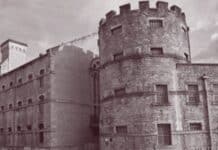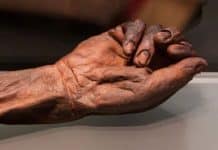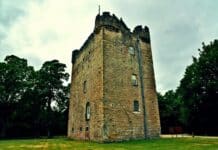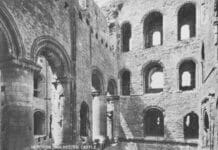ANN MASSEY tells us why Blackwater Castle is full of so much history, folklore and tales of haunting that you just have to find that special occasion to stay!
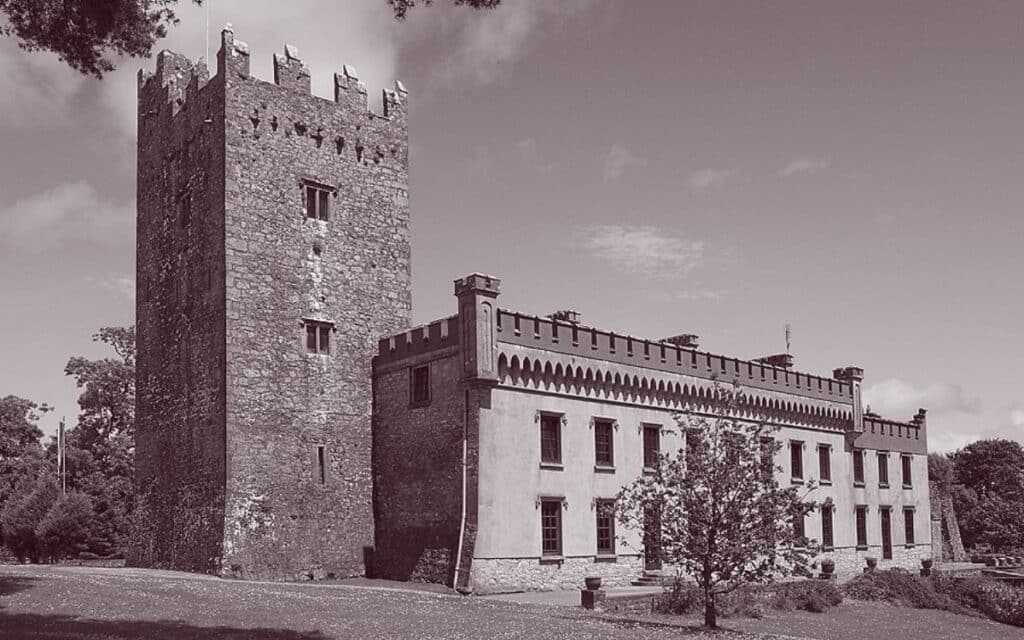
Blackwater Castle in Castletownroche in County Cork sits high above the River Awbeg, laying in 50 acres of woodland and landscaping, with the dramatic view a clue to its ancient beginnings. It has a chequered and layered past spanning centuries, entwined with folklore and haunting – together with notable visitors and an air of mysticism, it really is one of a kind. Here are my top five reasons to stay here!
Mesolithic Beginnings And A Bronze Age Fortress
The site on which Blackwater Castle stands dates back some 10000 years and the discovery of flint fragments shows it was the location for one of the first human settlements in County Cork and one of the very few sites in Ireland to have such a confirmed early history. Caves across the river from the castle contained finds of human inhabitation and remains.
From here a more deliberate construct of a holding wall has been discovered, showing it to be a more permanent fort or Dún Cruadha, purely chosen for its extreme defensive position, with a sheer rock face, surrounded by water and with resources to survive any attack or lengthy siege, a practice that continued over the centuries at the very same location and most likely a burial site as well.
Having already discovered flint, human remains and bronze age tools, this particularly door to the ancient past has only been pushed a jar and it will be an exciting opportunity for a full archaeological dig!
Druids, Magic and Women of Power
The site at Blackwater Castle forms part of an ancient area of extreme value called Caoille, dating back to the High Kings of Ireland, Druid Priests and magicians.
In the third century, the Irish High King was Cormac Mac Airt and he was determined to extort funds by way of unreasonable taxes from the High King of Munster, Fiacha Moilleathan.
Unsuccessful in his demands, Cormac reached out to his Druid priests who stopped the flow of water throughout the province, the people of Munster at his mercy. Refusing to give in, Fiacha turned his attention to County Kerry and the island of Valentia, where a blind but most powerful sorcerer by the name of Mogh Ruith resided.
The magician agreed to help in exchange for his choice of land anywhere in Munster. His immense powers brought water flowing back to the region, his breath creating storms and turning enemies to stone. Finally, he conjured the hounds of hell to rip apart Cormac’s Druid priests and force the High King back to his seat at Tara.
The land chosen by Mogh Ruith was Caoille, and within it the site of Blackwater Castle. The sorcerer was wed to the Hag of Beara, herself a demi-goddess of witch like powers. She was said to have murdered Mogh Ruith and both are thought to have been buried within a few miles of Blackwater Castle. In the location of the Hag’s Bed as her grave is called, an excavation of the site in the thirties revealed the skull of a woman.
A Sheela Na Gig, a crude stone carving of a female form with exaggerated vulva, was discovered at Blackwater Castle. There are few remaining, however they have been found in locations of importance or within the construction of medieval churches in the past.
While there is an ongoing academic debate on their arrival in Ireland, from Norman warnings against sin and lust to a symbol of the Divine Hag (there’s your connection to the Hag of Beara!), castle owner Patrick has a third opinion on its origin.
Women were the source of advice, herbal remedies, midwifery and indeed, magic for the most part. Patrick believes the stone carving was essentially a sign to show locals that wise women were nearby to come to for help and guidance.
Stepping Back In Time – One Castle, Three Different Centuries Joined Together
Blackwater Castle remained a stronghold for centuries, due to its premium location for natural resources and elite defence position. It is no surprise therefore, that in the twelfth century, the Normans arrived and made Dún Cruadha their home.
The first stone castle on the site over the River Awbeg was constructed and less than a hundred years later, the Roche family and Fermoy Barony began. A tower of that 12th century castle remains to this day and you can stand here, touch the past before moving just a few feet to the fifteenth century.
The Great Lord Roche, David Mór, wanted a symbol of his wealth and power to dominate the landscape and remind all below to fear and respect him. He built a Norman style keep towering 75 feet over the fast flowing river, with a wider base to withstand attack.
With its elevated position David and his men could see in every direction for miles and to this day you can still climb to the top of the tower, retracing the steps of the fearless Viscount of Fermoy and his descendants, the weight of history firmly sitting on your shoulders.
It is strange therefore, that just one wooden interior door separates three centuries, as you step from the cold, grey of fifteenth century Ireland to the more opulent and comfortable eighteenth century main house of Blackwater Castle.
Executions and Hauntings
In the 17th century, Maurice, Lord Roche and Viscount of Fermoy spent much of his time either imprisoned or in battle or debate protecting both his Catholic faith and lands from the hands of firstly Charles I and then Oliver Cromwell.
After a period of imprisonment in England, he returned to take up arms for the Catholic cause which meant he spent much time away from his home, Roche’s Castle as it was then known. His wife Lady Ellen, was no shrinking violet however – she vowed to defend their family home to the death, which ultimately she did.
Cromwell’s soldiers lay heavy siege to Blackwater Castle with cannon fire, as Lady Ellen and her men held on. Finally Lord Broghill and his senior officers were captured and executed on the spot, their bodies thrown from the battlements into the dark waters of the River Awbeg. Their screams are said to still be heard over the rush of the river.
Lady Ellen was arrested and held prisoner in the Norman Keep for two whole years before she was brought before the High Court on a bogus charge of promiscuity and murdering an unknown victim with a pistol, seen by an unknown witness and despite having an iron clad alibi.
The Lady Roche of Fermoy was hanged and her restless spirit is still said to haunt the Keep where she was captive.
A few paranormal teams have been fascinated by a visit the location and most recently, Irish Paranormal Investigations spent time covering the centuries of Blackwater Castle and seeking evidence of the supernatural.
Notable Occupants of Blackwater Castle
The very first Roche was Anglo-Norman David who made the area his home in the early thirteenth century, the name most likely meaning ‘rock’ and he would have been a man of Strongbow.
From here, the Roches were a warrior dynasty. Many were knighted by kings and many died in battle. David Mór is believed to be buried in nearby Bridgetown Priory in the Tomb of the Warrior. The Roche family merged with the heirs to the lands of Fermoy and an elite family line was born. Lord and Lady Roches of the ages with the additional titles of Lords and Viscounts of the Fermoy Barony.
Over the centuries they continued to be a thorn in the side of the Monarchy and Government, receiving written communications from Kings and even Elizabeth the First, as well as personal visits from the likes of Sir Walter Raleigh. And Oliver Cromwell. It must be said however that as with every family, loyalties were divided and some members of the Roche family died in defence of the Crown.
It was not long after the death of Lady Ellen, that the title of Viscount of Fermoy fizzled out and the Barony of Fermoy was transferred to Edmund Burke by Queen Victoria. His grandson was Edmund Maurice Burke Roche, 4th Baron Fermoy, the grandfather of Diana Spencer, the Princess of Wales.
In 1666, Blackwater Castle was gifted to Lieutenant Colonel John Widenham for his services to the Crown and he rebuilt the damage from Cromwell’s attack, renaming it Widenham Castle.
More recently, the castle was also used a place of solace and refuge for Michael Jackson shortly before his court cases and subsequent death, the troubled King of Pop finding a peace with his children at Blackwater Castle he was unable to recreate on his return to the United States. In a testament to the integrity of Patrick and Sheila Nordstrom who refused to allow a televised séance reaching out to the spirit of Michael Jackson to take place in their property.
Patrick’s father Rabbe and mother Ninna originally purchased Blackwater Castle in 1991. Their aim was to restore and maintain the history, heritage and culture of the location as well as advancements in the arts, literature and scientific development – all as close to the philanthropists’ hearts as it was to the Roche dynasty all those centuries ago.
Patrick and Sheila continue to follow his parents’ footsteps to this day and Sheila has even written her own novel relating to the Sheela na gig and her home. My thanks to the family for their hospitality and wealth of knowledge during my visit, a truly one of a kind castle, nestled in the heart of Roche country.
For a wonderfully-detailed, full history of Blackwater Castle, information on how to book a stay and for links to Sheila’s book, you can find them at https://www.blackwatercastle.com.
Have you been to Blackwater Castle? Tell us about your experience in the comments section below!


